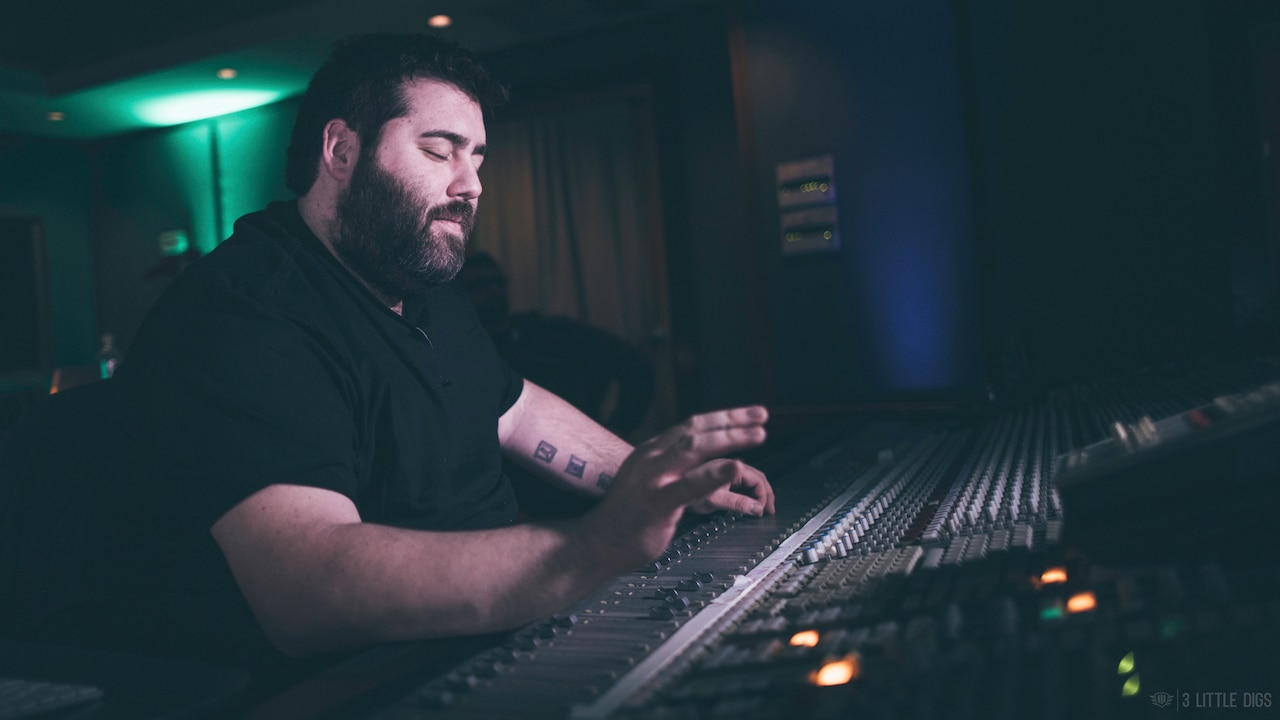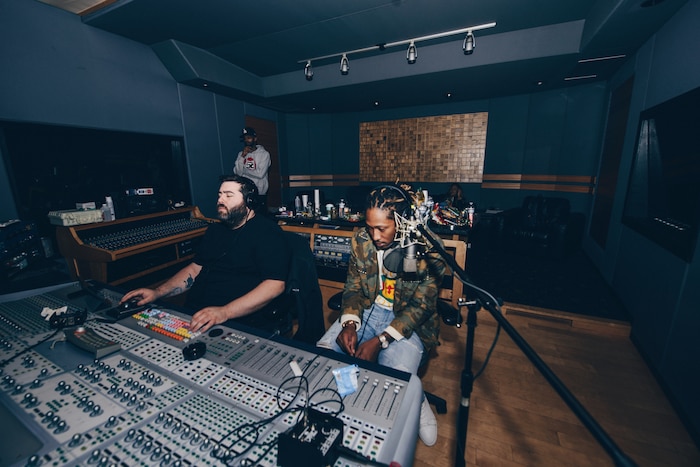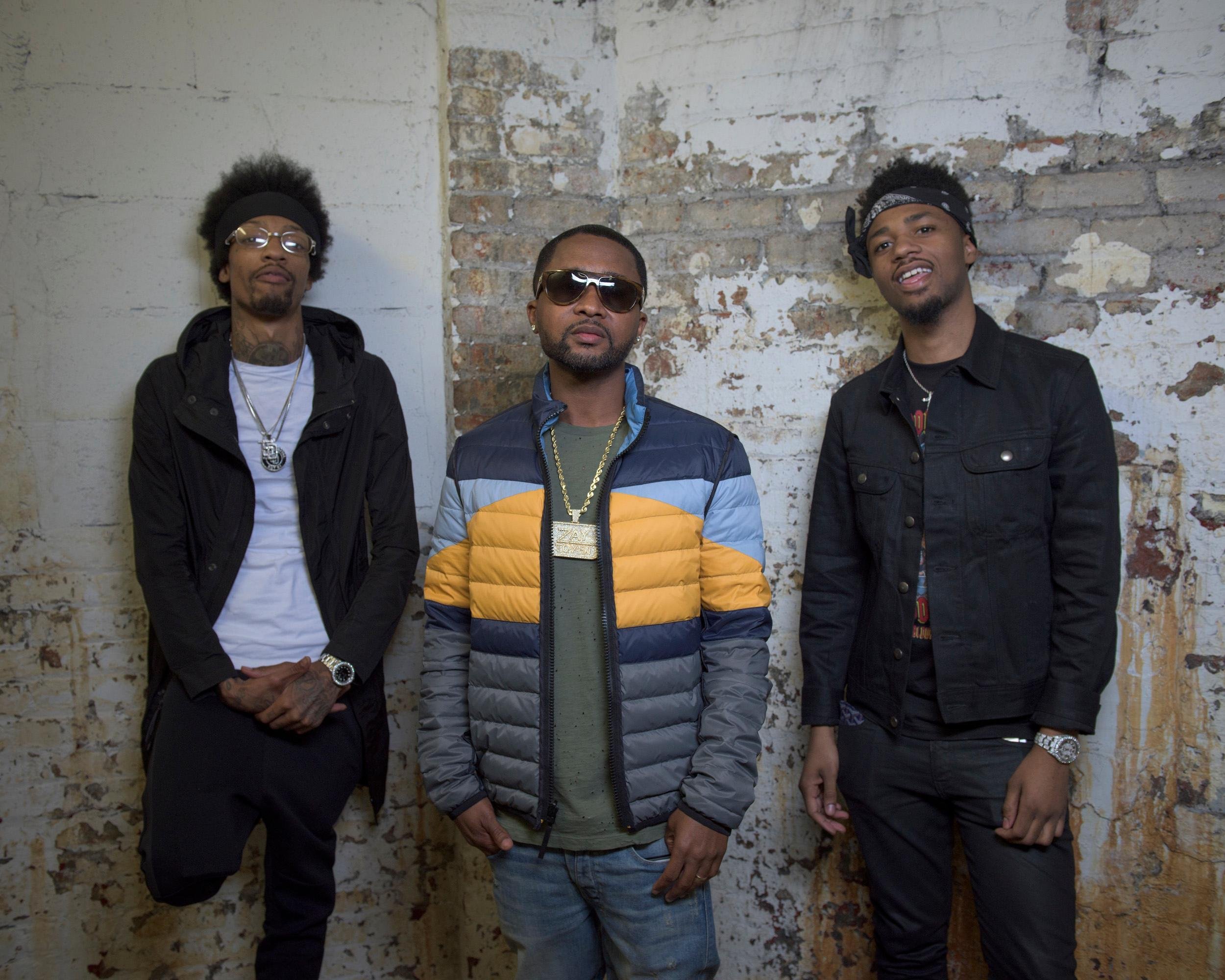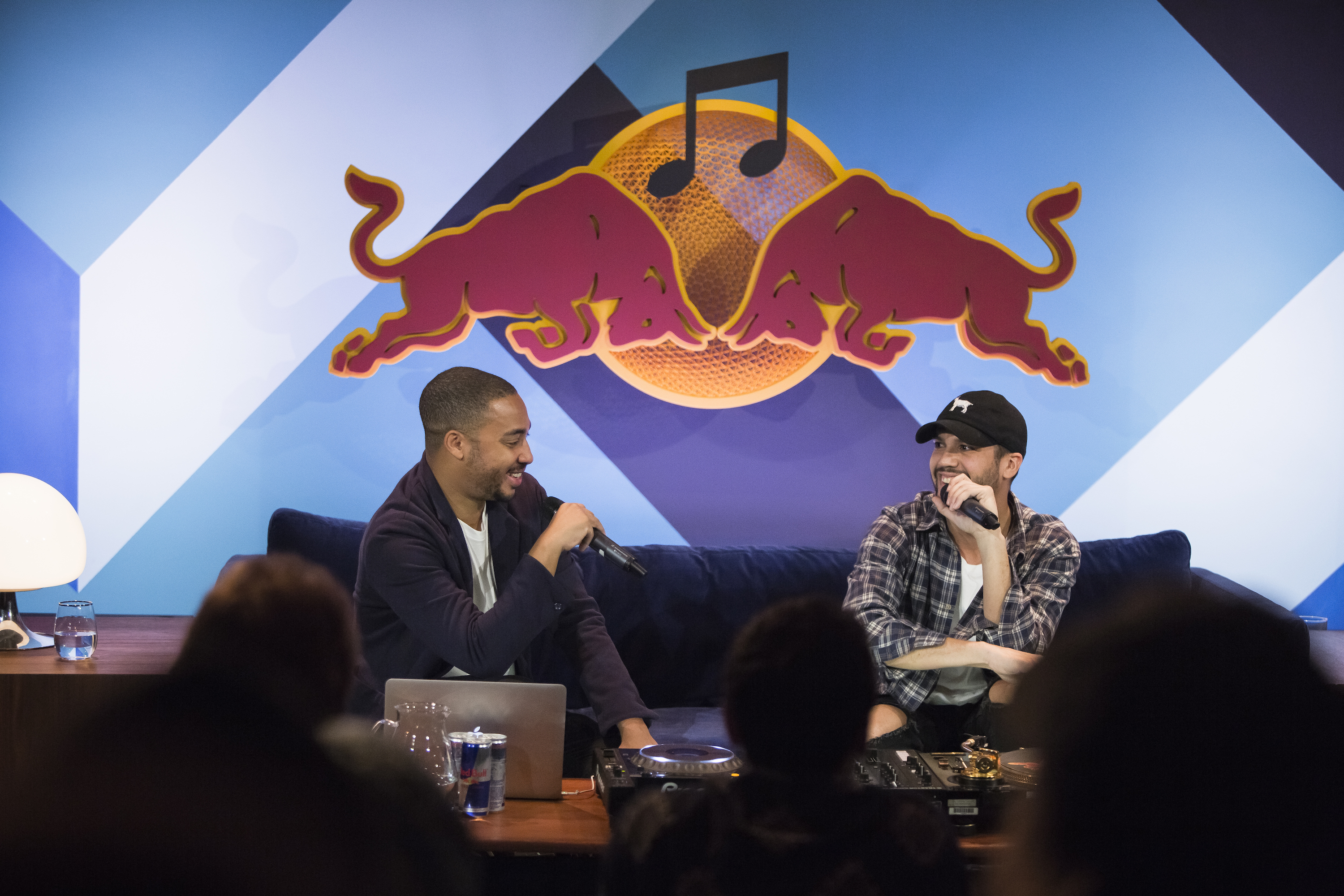Seth Firkins on Being Future’s Vocal Producer and the Power of Auto-Tune
The Atlanta-based engineer and producer goes deep on Future’s creative use of the embattled vocal software

I recently found myself standing behind a very expensive Neumann mic in the candlelit isolation booth of an Atlanta recording studio, cutting vocals with Seth Firkins. I’m not a vocalist, but that was kind of the point. A gregarious, burly Louisville native who’s been living and working in Atlanta for the last decade, Firkins is best known as Future’s go-to vocal producer and mix engineer, and we’d met to discuss the ins and outs of his craft. One of my big questions for Firkins was how far studio magic can take someone without much talent – more specifically, if Auto-Tune, the infamously ubiquitous pitch-correction software that’s become an essential component of Future’s vocal sound, is a corrective or substitute for actual skills. We decided the best test would be to see what Firkins could accomplish with a talentless hack, and, well, I knew a guy.
“You’ll know when it comes on,” Firkins told me through the talkback. While I did my best approximation of warm-ups, I watched Firkins dial in some basic vocal-track parameters in Pro Tools and listened as my voice transformed. A dab of reverb and quarter-note delay helped put me at ease – it’s a uniquely uncomfortable experience hearing your voice dry through a pair of headphones – but he was right about Auto-Tune. He punched in our chosen pop instrumental (Drake’s “Passionfruit”), set the key on the software and turned it on in the channel, and I immediately felt superhuman. The best comparison is walking through an airport and stepping onto one of those conveyor-belt walkways, where suddenly you’re walking twice as fast as everyone else with the same amount of effort. The notes weren’t hitting themselves, by any means, but I could get there with a lot less effort. And as silly as the exercise of recording a Drake cover may have been, I was nailing the takes.
Once Firkins had figured out the right software settings, he could focus on less technical manipulations, but he was at least as skilled a motivator as a technician. “That was 80%,” he said after I’d taken a couple of stabs at the first verse. It struck me as kind of a brilliant number, close enough to 100 to be half compliment, half nudge. “Remember, part of this is authenticity. Try to put yourself there. If you’re telling someone ‘Listen,’ tell them ‘Listen,’ you know what I mean?” He pointed out individual words to focus on in subsequent run-throughs, broke up the takes into manageable two-line chunks, started taking me off-piste with overdubbed harmonies and ad-libs as the inherent awkwardness of the recording session melted away. At some point, I stopped thinking about Auto-Tune entirely.
Firkins told me I could go fuck myself – I’d done considerably better than I think either of us had planned – and waved me back into the control room to hear a rough mix of the session. I wasn’t going to get a record contract, but I could see how a session like this one could catapult a proper singer into the stratosphere, how some combination of technology and psychology could make way for an outpouring of talent. Not surprisingly, when Firkins and I sat down to talk through the particulars of cutting vocals, he made clear that the hard work had little to do with knob-twiddling, whether he was aiming for a clean take or a Future-style transformation.
Put as simply as possible, what is vocal production?
It’s the ability to instill a certain amount of confidence, operational confidence. You kind of have to set the vibe, you know? The candles burning, make sure the headphone mix sounds right, make sure the artist can hear themselves. All these fall under vocal production guidelines in a sense. It comes down more to having not just everything right, but knowing when your artist has given you their best take. A lot of producers will say, “Hey, give me one more.” Well, for what? You’re just going to waste their voice, and you already got the best take that you can, so move on. Those are the responsibilities, about as simply as I can put it.
How did you come to work in vocal production?
Years of working as a tracking engineer. Most tracking engineers are, in at least minimal ways, vocal producers. They have to be. Like I said [before], the headphone mix – making sure that artists can hear themselves, making sure that if they want a little reverb, a little delay or a little flange, whatever their flavor is… hearing themselves as close to the final product as they can be gives them the confidence to be better the next take. When you hear yourself and it feels right and you’re like, “Man, I could really hit that note” – that’s vocal production, whether the tracking engineer necessarily means to do it or not.
Sounds like a big part of the job is psychological in a way.
Absolutely.
You’re the vibe master.
Vibe master… That’s a good way to put it.
But you’re also working with some pretty specific technology when you’re producing vocals. What are you doing on the engineering side?
A little bit of delay and a little bit of ’verb – it doesn’t matter if they’re stock or not. I tend to make sure that somebody sounds about as good as they can while they’re cutting to increase that confidence, to increase the, “I can really do this.” One of my main clients is Future, [who’s had] a notorious or illustrious career filled with Auto-Tune. That’s one of the tools in the kit that [Future and I] use every time we record.
The kit isn’t necessarily all that big. It’s really just making sure that the level coming in is as good as you can get with the equipment that you’re on, and that gain structure-wise, nothing is too hot or too low, and then giving them a little bit of effects. Nobody likes the singer to perform dry. The only people I could ever imagine doing that are voiceover artists. But if you’re singing a Cher cover, you need some effects, you need to feel like you’re on stage and performing to really make it convincing.
I’m not even judging – I’m just wondering, is it now a prerequisite for trap music that it has to be just drenched in a bunch of Auto-Tune?
Tell me about how you use Auto-Tune in a session. You mention Future gets it every time. Do you pretty much use it on every vocalist you’re producing?
No, no, no. Not at all.
So who gets it? Who needs Auto-Tune?
People who ask for it, number one. Clearly I’ll apply it to them. To be clear to the world, Future, in our entire career together – I’ve been rocking with him for six-plus years, and he has never asked me to turn Auto-Tune on. Do you know what I mean? He never says, “Hey, Firk, will you turn on...” It’s just always on with him. That’s just the vibe, that’s how we get the emotion out of him.
I come from when – and I’ll drop a name, Static Major, rest in peace, one of the bigger songwriters, did a lot of stuff for Aaliyah and Pretty Ricky. He’s from Louisville, as well as I am, and that was where I kind of cut my Auto-Tune teeth, because he was incredibly fast and demanded a really fast workflow. He used it, but it was for pitch correction. It wasn’t for the Future effect – it was really just pitch correction, and that’s the point. If you’re a singer, Auto-Tune is an amazing tool that can turn a decent take into a monster. Instantly.
People are much more demanding sonically than I think the industry gives them credit for. You may not necessarily be a musician, but you listen to music every day. Everyone listens to music, and everybody knows when they hear something that sounds good or bad. I use this all the time: everybody in a way is a mix engineer, because everybody’s got in a rental car and played with the treble and bass [on the stereo system]. They’re like, “No, that’s too much treble, let me turn it down a bit.” Granted, it’s over a finished track, but the theory is there. Part of what I do as an engineer, period, is make all this stuff translate. As a vocal producer, that’s part of what you’re doing: setting up the best possible scenario for artists to give you the best take, so that when you as a consumer listen to it, you’re impressed.
So there are two ways to employ Auto-Tune: using it to improve on something in a realistic way, and using it as more of a creative tool.
I try to say that it’s one of two ways. It’s either transparent or obvious. How do you want me to use it? If you want me to make it transparent, I can do that. I can make it seem like you just hit that song perfectly, and it does its job. I can also make it sound incredibly robotic, like T-Pain or Future or whatever. It just comes down to how you want it applied to your vocals.
Auto-Tune’s not just some effect – it’s an integral part of his emotion and his sound and his delivery.
It’s funny you mention T-Pain. This is an artist who, in a lot of ways, was this representation for a lot of people of Auto-Tune as, if not something bad, then something funny and gimmicky. That was just ten years ago. With an artist like Future, nobody makes fun of him for using it.
Not anymore, but yeah.
How did we come around to this point?
Wow, how did we get here? I’ve never really considered the distance – because you’re right when you put it in that perspective. It’s definitely a far cry from where it started to where it’s [now] almost not just acceptable but required. I hear so many of these cats come out today just dripping in Auto-Tune. I’m like, “OK, does anybody rap without it?” I’m not even judging – I’m just wondering, is it now a prerequisite for trap music that it has to be just drenched in a bunch of Auto-Tune?
I would like to consider Future one of the driving forces behind taking it from what T-Pain did – with no disrespect to him. I think we all appreciated its gimmicky quality when he sang. You just kind of loved it when it came on in a club and there was just so much energy behind it. [But I think Future] legitimized the effect as a viable source for emotion. Can he rap without it? Of course he can.
It almost sounds like Future has backed off on it a little bit. You hear more of his voice now on some of the more recent records.
I think it’s maturity, because I’m not necessarily doing anything different to him. Six years in the game with him, I haven’t changed anything about our workflow. And practice – think about how many thousands of hours we’ve spent working through the microphone with Auto-Tune. I think that he’s grown up, and I think he’s just gotten better and better at using it.
So he gets better at playing Auto-Tune as a vocalist.
People forget, this is, in a sense, an instrument. It’s not just some [effect] – it’s an integral part of his emotion and his sound and his delivery, and how he expects things he says and notes he hits to be bent and twisted. Nothing is by accident – well, I wouldn’t say nothing. Few things are by accident. And you know, something else about Future: I don’t think I’ve ever heard him recycle a hop. I’ll leave finger-pointing out of it, there’s no reason to bring that up, but there’s artists that are contemporary today that come on, you know it’s them because you know that hop. [Future] has steered away from that, and I think Auto-Tune has helped him, because every note is different in a sense. The delivery is different, and Auto-Tune has helped him achieve that.
Future had spent time in the studio before you came into the mix, right?
Future was already Future when I met him. He actually originally went by Meathead, when he was with the Dungeon Family. He was working with Steve Fisher at 11th Street Studios [in Atlanta]. Steve was his original engineer, and I was really just mixing. I would mix “Watch This” and “Yeah Yeah” – some of the original Future records. Then he went and did “Racks” with YC and kind of took the next step. He went from an artist in Atlanta to kind of a big deal in Atlanta, you know what I mean? That “Bravo, bravo, bravo” in the second verse… I was still going to clubs at that point in my life, and I remember going to clubs at night and just everybody, hands in the air, clapping, “Bravo, bravo, bravo!” Steve – of course, everything happens for a reason – Steve was transitioning from being an engineer and tracking to being more just a studio owner. Future’s street A&R at the time was [A1 Recordings president] G Propane. Pro would call me and be like, “Steve doesn’t really want to work tonight. You free?” I’m like, “Fuck yeah I’m free. I love Future! I’m there.” It kind of snowballed. No shame to Steve – he has his own vibe. But if you go listen to the original Dirty Sprite versus DS2, there’s your A and B.
Could you define that A and B? What do you think you brought to the mix?
I think what I brought to him was a level of clarity. That made him more viable. He was gonna be a superstar whether I was involved or not – I think I just helped speed the process up a little bit, because he sounded so much better. I think it was just production value and consistency.

That sort of signature Future vocal sound… Before Future, I can’t think of anyone who had ever quite sounded like that before. How do you take something that is so distinctive like that, and so alien, and keep developing it, when there’s no reference point for that sound other than that sound itself?
When you’re on the cutting edge of technology and music and you have somebody that’s so supremely talented, like Future, and somebody like myself, who, you know, without being pretentious, I like to think I’m pretty good at what I do – when you’re at that cutting edge, you have to trust in your own… “Do I like it?” It’s not about what you like or what she likes or what they like. It’s about, “Is this dope? Do we like it?” And we stuck with that. If you want to set a bar, that’s exactly what you have to do: you have to move the other bar out of the way, right? Or build a brand new one. We didn’t make a conscious effort to shift the paradigm; we just stuck with what we thought was dope and kept doing it, and the development of it really wasn’t intention. Like I said, my template for him always had Auto-Tune on it, so any time he walked in, the ’Tune was on there. We’ve been together for years, so it just started to become the sound.
I say “we” because I was there, but I still don’t want to take anything away from his talent. I can’t engineer air, right? I can’t just invent something and engineer it. You have to give me a hit to get a hit out of it, so no matter what I do or what I say, he still deserves the highest credit.
As a vocal producer, what can you do and what can’t you do?
I say this all the time: I don’t have a talent knob. I’ve got all this stuff around me, none of it I can turn up the talent with. You have to give me the bones and I can make something out of it. Most people can sing, despite what they think. Most people can actually sing if they had the confidence and authenticity about themselves. I can’t instill that in you past a certain point. You have to naturally want to be in that booth, and it’s intimidating. You want to sing in your shower and you want to sing at church, and you may do a great job at that, [but] put you in a booth… it’s a whole ’nother world in there. So I can change the pitch, I can put effects on, I can do a lot of stuff – but I still have to have the take. I still have to have the talent. That’s not something I can create with a computer.

